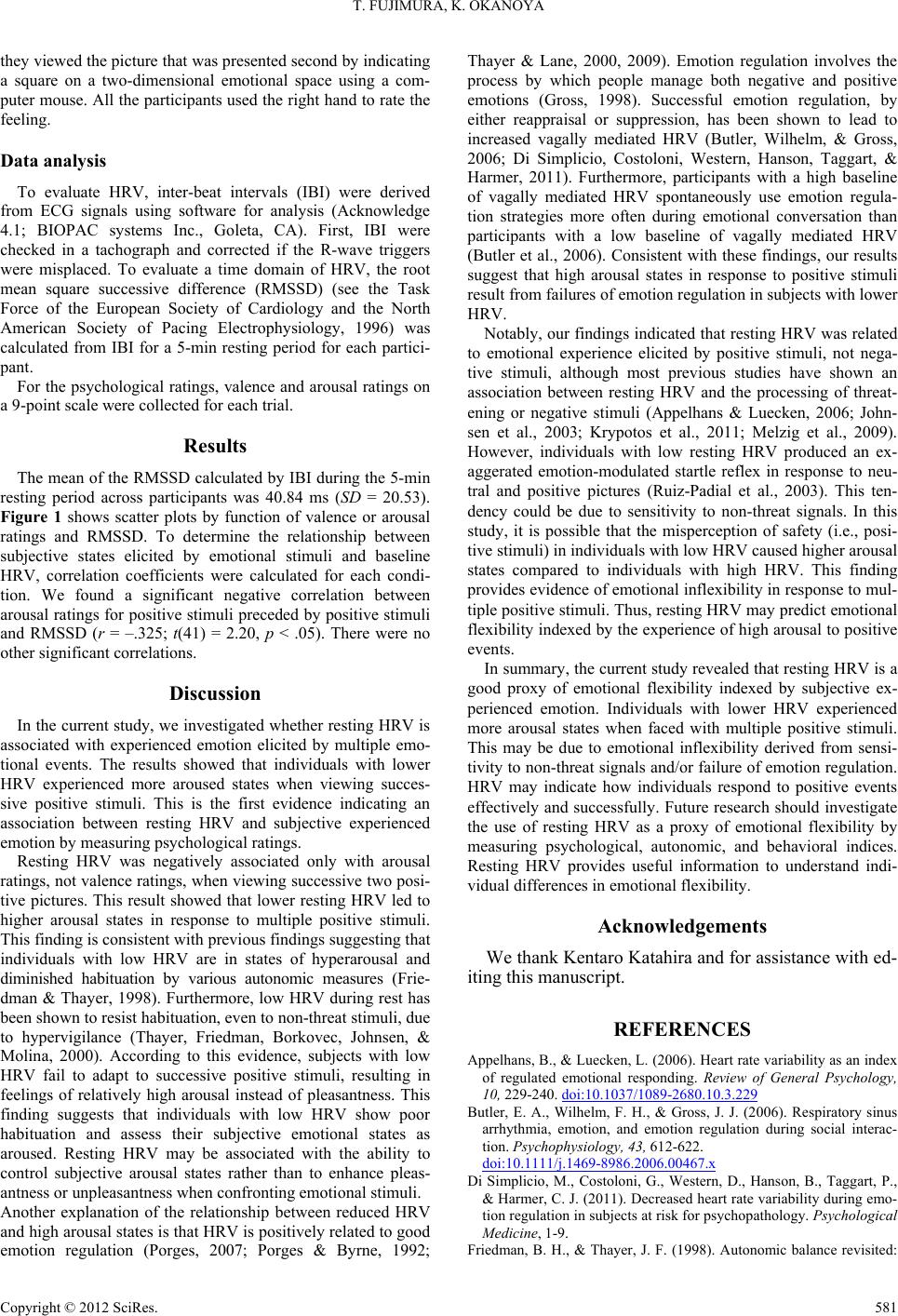
T. FUJIMURA, K. OKANOYA
they viewed the picture that was presented second by indicating
a square on a two-dimensional emotional space using a com-
puter mouse. All the participants used the right hand to rate the
feeling.
Data analysis
To evaluate HRV, inter-beat intervals (IBI) were derived
from ECG signals using software for analysis (Acknowledge
4.1; BIOPAC systems Inc., Goleta, CA). First, IBI were
checked in a tachograph and corrected if the R-wave triggers
were misplaced. To evaluate a time domain of HRV, the root
mean square successive difference (RMSSD) (see the Task
Force of the European Society of Cardiology and the North
American Society of Pacing Electrophysiology, 1996) was
calculated from IBI for a 5-min resting period for each partici-
pant.
For the psychological ratings, valence and arousal ratings on
a 9-point scale were collected for each trial.
Results
The mean of the RMSSD calculated by IBI during the 5-min
resting period across participants was 40.84 ms (SD = 20.53).
Figure 1 shows scatter plots by function of valence or arousal
ratings and RMSSD. To determine the relationship between
subjective states elicited by emotional stimuli and baseline
HRV, correlation coefficients were calculated for each condi-
tion. We found a significant negative correlation between
arousal ratings for positive stimuli preceded by positive stimuli
and RMSSD (r = –.325; t(41) = 2.20, p < .05). There were no
other significant correlations.
Discussion
In the current study, we investigated whether resting HRV is
associated with experienced emotion elicited by multiple emo-
tional events. The results showed that individuals with lower
HRV experienced more aroused states when viewing succes-
sive positive stimuli. This is the first evidence indicating an
association between resting HRV and subjective experienced
emotion by measuring psychological ratings.
Resting HRV was negatively associated only with arousal
ratings, not valence ratings, when viewing successive two posi-
tive pictures. This result showed that lower resting HRV led to
higher arousal states in response to multiple positive stimuli.
This finding is consistent with previous findings suggesting that
individuals with low HRV are in states of hyperarousal and
diminished habituation by various autonomic measures (Frie-
dman & Thayer, 1998). Furthermore, low HRV during rest has
been shown to resist habituation, even to non-threat stimuli, due
to hypervigilance (Thayer, Friedman, Borkovec, Johnsen, &
Molina, 2000). According to this evidence, subjects with low
HRV fail to adapt to successive positive stimuli, resulting in
feelings of relatively high arousal instead of pleasantness. This
finding suggests that individuals with low HRV show poor
habituation and assess their subjective emotional states as
aroused. Resting HRV may be associated with the ability to
control subjective arousal states rather than to enhance pleas-
antness or unpleasantness when confronting emotional stimuli.
Another explanation of the relationship between reduced HRV
and high arousal states is that HRV is positively related to good
emotion regulation (Porges, 2007; Porges & Byrne, 1992;
Thayer & Lane, 2000, 2009). Emotion regulation involves the
process by which people manage both negative and positive
emotions (Gross, 1998). Successful emotion regulation, by
either reappraisal or suppression, has been shown to lead to
increased vagally mediated HRV (Butler, Wilhelm, & Gross,
2006; Di Simplicio, Costoloni, Western, Hanson, Taggart, &
Harmer, 2011). Furthermore, participants with a high baseline
of vagally mediated HRV spontaneously use emotion regula-
tion strategies more often during emotional conversation than
participants with a low baseline of vagally mediated HRV
(Butler et al., 2006). Consistent with these findings, our results
suggest that high arousal states in response to positive stimuli
result from failures of emotion regulation in subjects with lower
HRV.
Notably, our findings indicated that resting HRV was related
to emotional experience elicited by positive stimuli, not nega-
tive stimuli, although most previous studies have shown an
association between resting HRV and the processing of threat-
ening or negative stimuli (Appelhans & Luecken, 2006; John-
sen et al., 2003; Krypotos et al., 2011; Melzig et al., 2009).
However, individuals with low resting HRV produced an ex-
aggerated emotion-modulated startle reflex in response to neu-
tral and positive pictures (Ruiz-Padial et al., 2003). This ten-
dency could be due to sensitivity to non-threat signals. In this
study, it is possible that the misperception of safety (i.e., posi-
tive stimuli) in individuals with low HRV caused higher arousal
states compared to individuals with high HRV. This finding
provides evidence of emotional inflexibility in response to mul-
tiple positive stimuli. Thus, resting HRV may predict emotional
flexibility indexed by the experience of high arousal to positive
events.
In summary, the current study revealed that resting HRV is a
good proxy of emotional flexibility indexed by subjective ex-
perienced emotion. Individuals with lower HRV experienced
more arousal states when faced with multiple positive stimuli.
This may be due to emotional inflexibility derived from sensi-
tivity to non-threat signals and/or failure of emotion regulation.
HRV may indicate how individuals respond to positive events
effectively and successfully. Future research should investigate
the use of resting HRV as a proxy of emotional flexibility by
measuring psychological, autonomic, and behavioral indices.
Resting HRV provides useful information to understand indi-
vidual differences in emotional flexibility.
Acknowledgements
We thank Kentaro Katahira and for assistance with ed-
iting this manuscript.
REFERENCES
Appelhans, B., & Luecken, L. (2006). Heart rate variability as an index
of regulated emotional responding. Review of General Psychology,
10, 229-240. doi:10.1037/1089-2680.10.3.229
Butler, E. A., Wilhelm, F. H., & Gross, J. J. (2006). Respiratory sinus
arrhythmia, emotion, and emotion regulation during social interac-
tion. Psychophysiology, 43, 612-622.
doi:10.1111/j.1469-8986.2006.00467.x
Di Simplicio, M., Costoloni, G., Western, D., Hanson, B., Taggart, P.,
& Harmer, C. J. (2011). Decreased heart rate variability during emo-
tion regulation in subjects at risk for psychopathology. Psychological
Medicine, 1-9.
Friedman, B. H., & Thayer, J. F. (1998). Autonomic balance revisited:
Copyright © 2012 SciRes. 581